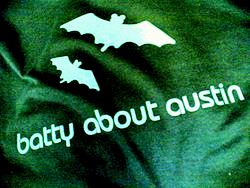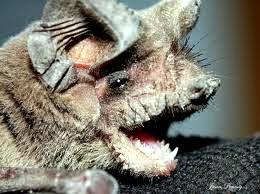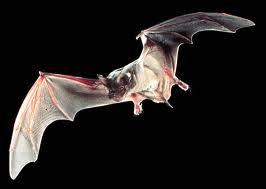» posted on Friday, March 2nd, 2012 by Linda Lou Burton
The Ladies and the Bats
 Linda Burton posting from Austin, Texas – Aw shucks, I’m going to miss the bats. Austin is famous for its music, its food, and a really odd thing that has always puzzled me. Part of Austin’s cultural identity is caught up in bats. And I don’t mean baseball bats, I mean the kind that fly around at night eating insects. The story goes like this: the Ann W Richards Congress Avenue Bridge (named after the 45th governor of the state of Texas), which crosses over Lady Bird Lake (named after the former First Lady of the United States and created by the Longhorn Dam on the Colorado River) is home to a large urban bat colony. These bats, on their nightly flying and eating quest, attract about 100,000 tourists annually and impact the city economically to the tune of $8
Linda Burton posting from Austin, Texas – Aw shucks, I’m going to miss the bats. Austin is famous for its music, its food, and a really odd thing that has always puzzled me. Part of Austin’s cultural identity is caught up in bats. And I don’t mean baseball bats, I mean the kind that fly around at night eating insects. The story goes like this: the Ann W Richards Congress Avenue Bridge (named after the 45th governor of the state of Texas), which crosses over Lady Bird Lake (named after the former First Lady of the United States and created by the Longhorn Dam on the Colorado River) is home to a large urban bat colony. These bats, on their nightly flying and eating quest, attract about 100,000 tourists annually and impact the city economically to the tune of $8  million a year. There are a million bats living under Ann Richard’s bridge over Lady Bird’s lake; which means there are more bats than people in Austin. It’s a spectacular sight, I’m told; gather on the bridge, or in boats, or on either side of the river just about dusk to watch. But alas, they haven’t come back to Austin from their winter vacation in Mexico yet; mid-March is a typical arrival time. Since I won’t get to see the little critters, I researched a few Bat Facts.
million a year. There are a million bats living under Ann Richard’s bridge over Lady Bird’s lake; which means there are more bats than people in Austin. It’s a spectacular sight, I’m told; gather on the bridge, or in boats, or on either side of the river just about dusk to watch. But alas, they haven’t come back to Austin from their winter vacation in Mexico yet; mid-March is a typical arrival time. Since I won’t get to see the little critters, I researched a few Bat Facts.
 Austin’s bats are Mexican free-tailed bats, reddish to dark brown or gray in color. Would they win Bat Beauty Pageants with their broad, forward-pointing ears and their wrinkled lips? Perhaps only a mother could love them – a female has a single baby (called a pup) in the summer months; the babies roost separately from their mothers, staying in the warmest and highest sections of the cave, or bridge, that they call home. Imagine coming home from an evening of feeding and searching for your baby among thousands of others in the “maternity ward.” Those who study bats believe they identify each other by their call. That maternal instinct only goes so far; if a baby falls to the floor of the cave, or in Austin’s case, to the ground or water underneath the bridge, the mother does not fly to the rescue.
Austin’s bats are Mexican free-tailed bats, reddish to dark brown or gray in color. Would they win Bat Beauty Pageants with their broad, forward-pointing ears and their wrinkled lips? Perhaps only a mother could love them – a female has a single baby (called a pup) in the summer months; the babies roost separately from their mothers, staying in the warmest and highest sections of the cave, or bridge, that they call home. Imagine coming home from an evening of feeding and searching for your baby among thousands of others in the “maternity ward.” Those who study bats believe they identify each other by their call. That maternal instinct only goes so far; if a baby falls to the floor of the cave, or in Austin’s case, to the ground or water underneath the bridge, the mother does not fly to the rescue.
 Their choice of the Ann Richards Bridge is a good one; the water of Lady Bird Lake allows them the opportunity to drink, and attracts the insects they eat. They love moths (great!), beetles, dragonflies, flies, wasps, and ants, and may consume as much as 200 tons of insects every night. And these little food machines only weigh 0.5 oz with a length of 3-5 inches.
Their choice of the Ann Richards Bridge is a good one; the water of Lady Bird Lake allows them the opportunity to drink, and attracts the insects they eat. They love moths (great!), beetles, dragonflies, flies, wasps, and ants, and may consume as much as 200 tons of insects every night. And these little food machines only weigh 0.5 oz with a length of 3-5 inches.
They may live as long as 18 years, and they fly very fast; they are known as the “jets” of the bat world. Watch your head!
